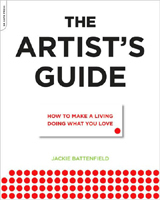Jackie Battenfield’s The Artist’s Guide:
How to make a living doing what you love (2009). Recent grad review from the UK
What does it really take to sustain a professional practice as an artist when the big money is not thrown your way? How to do it when many university programs still don’t offer enough training? According to our UK reviewer, this book may offer real guidance to some very real questions.
Creative Business & Entrepreneurship | 11 November 2009
After just a few months of complete independence after getting my BA in Fine Art, I feel completely lost with little idea of how to survive in the art world. Having been in solid education for the last 17 years, I graduated this summer and have little knowledge of the business.
The Artist’s Guide is aimed at Art graduates, like myself, to help them help themselves, and demystify the process. This book isn’t a step-by-step guide on how to become famous, but how to achieve the goals you want at any level The book also offers flexible, realistic ways of achieving this.

It reads like an in-depth tutorial with someone who knows exactly where you’re coming from, with enough tough love to ensure you keep your feet on the ground. Battenfield presumes you know very little about how to be a professional artist, so gives user-friendly action plans which emphasise the need to be active and take responsibility for your own success. There are also tasks to complete throughout the guide that genuinely help you to find out what you want, and the best way to do so without selling your soul to a part-time job you resent. All her advice is backed up with resources including websites, so the guide is practical rather than filled with empty words.
The guide starts with basic planning which matches the limited professional training provided during my degree, and is generally common sense. However this makes it very easy-to-read, with clear sections and advice from real experiences that aren’t too overwhelming.
Ignoring the initial baby-feeding approach, the guide is reassuring, making the process coherent and most importantly, possible. The artist statement section is particularly good. During my degree I felt like I was discouraged from writing them, but Battenfield stresses their importance for various reasons, including press releases.
One part I found very interesting was on the artist’s studio. Most UK universities provide studio spaces for the full three years, and bedrooms often become brilliant make-shift spaces once the real thing has gone. However, Battenfield explains how important hiring your own studio really is, not just to use as a separate creative space, but for viewing and business opportunities. Where to find said studio is another matter. The guide reads as if you graduate with a ready-made studio and leaves the important issue of where to find one up to internet search engines.
The entire section on finance and funding is mostly irrelevant to a UK graduate, as the book is US-focused. A large chunk talks about national interest, trusts and non-profit organisations, backed up by American sources. Coming from someone who knows very little about business and art politics, I have to presume that there are equivalent organisations in the UK, and that the ways to approach them are culturally transferable.
However, as the advice can be applied to a British context, the guide is very useful and undeniably honest. Battenfield provides a hands-on approach rather than a written lecture; the Artist’s Guide is comparable to an on-going tutorial you can pick up and put down at will. She consistently stresses the importance of self-generated success rather than lying around waiting for something to happen. This is indispensable advice as there is no weaning off process once you finish university, but this guide is a substantial push in the right direction.
The Artist’s Guide: How to make a living doing what you love is published by Da Capo Press. For more information and reviews, click the link above the article.